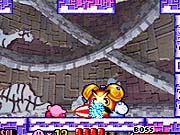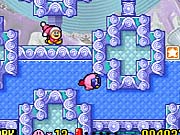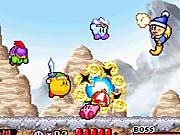Nintendo's run of nostalgic remakes continues with Kirby: Nightmare in Dream Land. It's actually a revamp of the 1993 NES game Kirby's Adventure. The graphics have been brought up to modern standards, and the gameplay and level designs are intact with minor alterations, the majority of which are positive. As Kirby, you are a cute, floating puffball who can inhale and absorb his enemies' abilities. The game itself plays much like an installment in the Super Mario Bros. series, except that Kirby can fly and the difficulty isn't nearly as serious.

Kirby's motivation is to help his fellow residents of Dream Land, who are unable to dream because King DeDeDe has stolen the Rod of Dreams. In order to reclaim the rod, Kirby must visit the seven different realms of Dream Land and battle DeDeDe's followers. In practical terms, this means you'll visit roughly 40 different stages and be able to absorb the abilities of approximately 30 different enemies. There are also a dozen nightmare characters strewn throughout the game that you'll battle at frequent intervals in order to acquire rare abilities or reclaim a portion of the Rod of Dreams.
Compared with similar games, Kirby: Nightmare in Dream Land isn't that innovative or challenging. Each stage scrolls from left to right or bottom to top. Along the way, you need to avoid enemies and hazards, such as the spike pits and cannons that are typical of other side-scrolling adventure games. Kirby can walk, jump, swim underwater, and float in midair. In most cases, you can access the exit for a particular area without ever interacting with a single enemy. At the same time, you have six hit points to squander before losing a life, and there are numerous chances to gain additional lives.

Variety is the factor that makes Kirby: Nightmare in Dream Land so enjoyable. Most of the enemies in the game have unique attacks that they try to spring on Kirby, but you can turn these attacks against them by inhaling their bodies and absorbing their abilities. The number of different attacks you can acquire is staggering. There are at least two dozen separate abilities, some of which can be mixed together. Notable examples include flame breath, a sword, porcupine spikes, and a laser beam. One of these abilities even lets you transform into a rock to drop on enemies. You can't move while the rock is on the ground, but you can't lose any hit points, either. An added challenge is to attempt to complete the game with a 100 percent ranking, which you can only achieve by discovering every hidden door. Some doors are located in hard-to-reach areas, and some require that you use a specific ability to clear away obstacles. Part of the game's charm is that there are so many different things to try in order to find these hidden doors. Your rewards on the other side of these doors are extra lives, new abilities, and arenas where you can fight bosses you've previously defeated. The dozen or so bosses you'll encounter throughout the main quest will also spice things up a bit, since they generally have clever attack patterns and are vulnerable to specific abilities.
For all practical purposes, Kirby: Nightmare in Dream Land is a brand-new game. The gameplay is identical to that of Kirby's Adventure, but there are numerous changes and improvements that affect almost every other aspect of the game. If you owned Kirby's Adventure for the NES, you probably won't recognize Nightmare in Dream Land. By the same token, if you're just now discovering Kirby for the first time, you'll be hard-pressed to find any feature of the game that seems dated or otherwise out of sorts with the other adventure games that are available for the Game Boy Advance.
The most obvious change is the improvement in graphics. Nintendo redid all the artwork from Kirby's Adventure, such that the backgrounds now have multiple layers of scrolling and added depth thanks to an increase in colors. The character sprites, including Kirby, have been redrawn to look cuter and livelier. Kirby has a different costume or hat that he wears to represent each of his abilities. Bosses are twice as large as they were in the NES version of the game, and they animate with a greater range of expression that better shows their facial responses. There are also a number of finer details to observe that further distinguish the game from its NES precursor. The flame effects that emanate from Kirby's fire ability are laden with smoke and burn more richly. The transparency effect used underwater is nicer, and it's also more amusing since Kirby now wears a snorkel while swimming. The end result of all these graphical upgrades is that Kirby: Nightmare in Dream Land looks strikingly different from and better than Kirby's Adventure. The game still isn't quite up to par with Yoshi's Island or Castlevania: Harmony of Dissonance in terms of color variety or number of independent scrolling backgrounds, but considering the pervasive cute factor, that's not a significant complaint.

Alongside the visual update, the music and sound effects have received an overhaul. The improvements aren't as clear cut, but a side-by-side comparison with Kirby's Adventure reveals that there are generally more instruments present on each musical track and the sound effects are more imposing. With the addition of few new speech samples, you'll also get to hear Kirby squeak out an "ouch" or a "yay" once in a while. The overall soundtrack isn't as robust or varied as that of other well-received GBA adventure games, but it's more than sufficient for the whimsical gameplay in Nightmare in Dream Land.
Although it would be a waste of space to point out all the differences between the older Kirby's Adventure and Kirby: Nightmare in Dream Land, there are some changes worth noting, since they speak to Nintendo's efforts to enhance the product. The three secondary games you'll encounter at various points throughout the game in order to earn additional lives have been changed. The first, quick-draw, is a secondary game in which you attempt to attack your opponent before they attack you, but only after a buzzer sounds. Bomb rally is similar to tennis, except that you're lobbing a bomb back and forth until it detonates on someone. The last secondary game is called air grind. It's a minigame in which you need to ride a skateboard over a rainbow and grind across the smooth portions. The most impressive aspect of this game, however, is that there are three other opponents competing against you, and they are weaving closer and further from the screen and scaling larger and smaller as they do so.

The reason for the inclusion of new secondary games is that they're all multiplayer-capable. In fact, Kirby: Nightmare in Dream Land has support for up to four players in all of its gameplay modes--something that wasn't true of Kirby's Adventure. With only a single cartridge and four systems, you can compete against your friends in the three secondary games mentioned above. If all three of your friends have a copy of the game, you can play through the main quest as a group. Each Kirby will have a unique color scheme, and you can interact with one another while fighting enemies and searching for hidden doors.
Kirby: Nightmare in Dream Land makes up for its simplistic gameplay and brief quest with a great deal of variety. The addition of multiplayer features is great, but solo players can still keep themselves occupied by endeavoring to unlock the more difficult "extra" mode. Nonetheless, you need to remember that the game itself isn't as extensive or diverse as Yoshi's Island or Metroid Fusion. That said, it complements them nicely and is well suited to younger players or the young at heart.